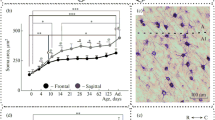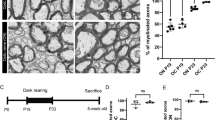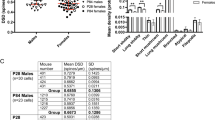Summary
The effects of light deprivation on the number of apical dendritic spines have been studied in the visual cortex of the mouse. In the portion of the apical dendrites of layer V-pyramidal cells traversing layer IV, dendritic segments of 50 μ in length from different cells were selected. The number of spines on each of 50 different segments per animal was counted. The countings were done in the areae striata and temporalis prima from mice raised in complete darkness since birth up to 22–25 days old. The observations were compared with the countings obtained in the areae striata and temporalis prima from mice raised under normal conditions. The results indicated that mice raised in darkness had a significant reduction in the number of spines per dendritic segment at the level of layer IV in area striata when compared with control animals. No significant difference was found in the number of spines per dendritic segment in layer IV between both groups of normal and dark raised mice in the area temporalis prima. The mean number of dendritic spines per consecutive segments along complete apical dendrites of layer V-pyramidal cells in area striata has been found to increase exponentially with the distance from the cell body. The same exponential relation, but with somewhat lower values, was obtained in the apical dendrites in area striata in mice raised in darkness. The significance of these findings were discussed. It was concluded that: First, visual sensory deprivation affect the fine structure of the central nervous system. Second, the results observed support the assumption that structural changes in the nerve cells occur as the result of experience.
Similar content being viewed by others
References
Bennett, E.L., M.C. Diamond, D. Keech and M. R. Rosenzweig: Chemical and anatomical plasticity of brain. Science 146, 610–619 (1964).
Bishop, G.H.: The dendrite: receptive pole of the neurone. EEG Clin. Neurophysiol. suppl. 10, 12–21 (1958).
Brattgård, S. O.: The importance of adequate stimulation for the chemical composition of retinal ganglion cells during early post-natal development. Acta Radiol. suppl. 96, 1–80 (1952).
Cajal, S.R.: Sur la structure de l'écorce cerebrate de quelques mammifères. La Cellule 7, 1–54 (1891).
—: Histologie du système nerveux de l'homme et des vertébrés, vol. II. Paris: A. Maloine 1911. Reimpress. Madrid: Instituto Cajal 1955.
Carlson, A.J.: Changes in the Nissl's substance of the ganglion and the bipolar cells of the retina of the Brandt cormorant Phalacrocorax pencillatus during prolonged normal stimulation. Amer. J. Anat. 2, 341–347 (1902–1903).
Chow, K.L., A.H. Riesen and F.W. Newell: Degeneration of retinal ganglion cells in infant chimpanzees reared in darkness. J. comp. Neurol. 107, 27–42 (1957).
Coleman, P.D.: Effects of rearing in the dark on dendritic fields of stellate cells in visual cortex. Communication presented at the Meeting of the Amer. Ass. Adv. Sci. Berkeley, California. Dec. 28 (1965).
Colonnier, M.: The structural design of the neo-cortex. In: Study week on brain and conscious experience, pp. 1–32. Città del Vaticano: Pontificia Academia Scientiarum 1965.
Diamond, M. C., D. Krech and M.R. Rosenzweig: The effects of an enriched environment on the histology of the rat cerebral cortex. J. comp. Neurol. 123, 111–120 (1964).
Eccles, J.C.: The physiology of synapses. New York: Academic Press Inc. 1964.
Globus, A., and A.B. Scheibel: Loss of dendrite spines as an index of pre-synaptic terminal patterns. Nature (Lond.) 212, 463–465 (1966).
Gray, E. G.: Electron microscopy of synaptic contacts on dendrite spines of the cerebral cortex. Nature (Lond.) 183, 1592–1593 (1959a).
—: Axo-somatic and axo-dendritic synapses of the cerebral cortex: an electron microscope study. J. Anat. (Lond.) 93, 420–433 (1959b).
—, and R.W. Guillery: A note on the dendritic spine apparatus. J. Anat. (Lond.) 97, 389–392 (1963).
Gyllensten, L.: Postnatal development of the visual cortex in darkness (mice). Acta morphol. neerl. -scand. 2, 331–345 (1959).
—, T. Malforms and M.-L. Norrlin: Growth alteration in the auditory cortex of vistially deprived mice. J. comp. Neurol. 126, 463–470 (1966).
Hamlyn, L.H.: Electron microscopy of mossy fibre endings in Ammon's horn. Nature (Lond.) 190, 645–646 (1961).
—: An electron microscope study of pyramidal neurons in the Ammon's horn of the rabbit. J. Anat (Lond.) 97, 189–201 (1963).
Holloway, R.L.: Dendritic branching: some preliminary results of training and complexity in rat visual cortex. Brain Res. 2, 393–396 (1966).
Jones, W.H., and D.B. Thomas: Changes in the dendritic organization of neurons in the cerebral cortex following deafferentation. J. Anat. (Lond.) 96, 375–381 (1962).
Le Gros Clark, W.E.: Inquires into the anatomical basis of olfactory discrimination. Proo. roy. Soc. B. 146, 299–319 (1957).
Lorente De Nó, R.: Cerebral cortex: architecture, intracortical connections, motor projections. In: Fulton's Physiology of the nervous system, pp. 288–330. London: Oxford University Press 1949.
Mann, G.: Histological changes induced in sympathetic, motor, and sensory nerve cells by functional activity. (Preliminary note.) Read before the Scottish Micr. Soc. under the title: “What alterations are produced in nerve cells by work ?”. May 18 (1894).
Matthews, M.R., and T.P.S. Powell: Some observations on transneuronal cell degeneration in the olfactory bulb of the rabbit. J. Anat. (Lond.) 96, 89–102 (1962).
Nauta, W.J.H.: Terminal distribution of some afferent fiber systems in the cerebral cortex. Anat. Rec. (Abstr.) 118, 333 (1954).
O'leary, J.L.: Structure of the area striata of the cat. J. comp. Neurol. 75, 131–164 (1941).
Pappas, G.D., and D.P. Purpura: Fine structure of dendrites in the superficial neocortical neuropil. Exp. Neurol. 4, 507–530 (1961).
Polyak, S.: The vertebrate visual system. Chicago: The University of Chicago Press 1957.
Riesen, A.H.: Effects of stimulus deprivation on the development and atrophy of the visual sensory system. Amer. J. Orthopsychiat. 30, 23–36 (1960).
Rose, M.: Cytoarchitektonischer Atlas der Großhirnrinde der Maus. J. Psychol. Neurol. (Lpz.) 40, 1–51 (1929).
Rosenzweig, M.R., D. Krech, E.L. Bennett and M.C. Diamond: Effects of environmental complexity and training on brain chemistry and anatomy: a replication and extension. J. comp. physiol. Psychol. 55, 429–437 (1962).
Shkolnik-yarros, E.G.: Neurons and interneuronal connections. The visual analyzer. Leningrad: Academy of Medical Sciences, USSR 1965.
Sholl, D.A.: Dendritic organization in the neurons of the visual and motor cortices of the cat. J. Anat. (Lond.) 87, 387–406 (1953).
—: The organization of the cerebral cortex. London: Methuen and Co. Ltd. 1956.
Valverde, F.: Studies on the piriform lobe. Cambridge: Harvard University Press 1965.
Wase, A.W., and J. Christensen: Stimulus deprivation and phospholipid metabolism in cerebral tissue. Arch. Gen. Psychiat. 2, 171–173 (1960).
Weiskrantz, L.: Sensory deprivation and the cat's optic nervous svstem. Nature (Lond.) 181, 1047–1050. (1958).
Whittaker, V.P., and E.G. Gray: The synapse: biology and morphology. Brit. med. Bull. 18, 223–228 (1962).
Wiesel, T.N., and D.H. Hubel: Effects of visual deprivation on morphology and physiology of cells in the cat's lateral geniculate body. J. Neurophysiol. 26, 978–993 (1963a).
—, and —: Single-cell responses in striate cortex of kittens deprived of vision in one eye. J. Neurophysiol. 26, 1003–1017 (1963b).
—, and —: Extent of recovery from the effects of visual deprivation in kittens. J. Neurophysiol. 28, 1060–1072 (1965).
Wilson, P.D., and A.H. Riesen: Visual development in rhesus monkeys neonatally deprived of patterned light. J. comp. physiol. Psychol. 61, 87–95 (1966).
Author information
Authors and Affiliations
Rights and permissions
About this article
Cite this article
Valverde, P. Apical dendritic spines of the visual cortex and light deprivation in the mouse. Exp Brain Res 3, 337–352 (1967). https://doi.org/10.1007/BF00237559
Received:
Issue Date:
DOI: https://doi.org/10.1007/BF00237559




